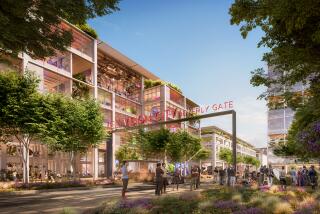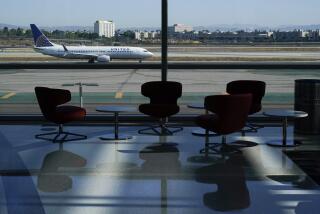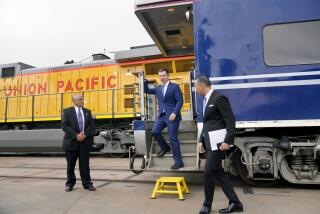Officials Join Residents’ Fight Against Larger Air Terminal
- Share via
Los Angeles City Councilmen Zev Yaroslavsky and Joel Wachs joined a group of Burbank Airport neighbors Wednesday who protested plans to replace the airport’s terminal with a larger building capable of handling more flights and passengers.
Yaroslavsky and about 160 people turned out at the Beverly Garland Hotel in North Hollywood for the second and final public hearing on an environmental study into the effects of replacing the terminal with a building three to four times larger.
Federal Aviation Administration officials have ordered the terminal, built in 1930, replaced because it is too close to the runways to meet modern safety standards.
Yaroslavsky and most of the speakers complained that a larger terminal will attract more passengers and flights, increasing noise and traffic in nearby Los Angeles neighborhoods.
“Nobody is against the Burbank Airport as a use . . . but all we are saying is there is a way for this airport to be a good neighbor,” Yaroslavsky said.
Wachs added: “It’s time for this airport to tell us what it has in store for the future.”
Among other speakers opposed to the expansion were aides to Assemblymen Burt Margolin (D-Los Angeles) and Terry B. Friedman (D-Los Angeles), and Reps. Howard L. Berman (D-Panorama City) and Henry A. Waxman (D-Los Angeles), all of whom represent areas surrounding the airport.
Among residents who complained about the expansion was Ethel Scar, a 10-year resident of Sherman Oaks. “I live in the flight path of the airport and I will tell you now the noise is intolerable,” she said.
The same concerns were raised in a report issued last week by the city’s chief legislative analyst, who said the airport’s environmental study underestimates the effects of a larger terminal on surrounding neighborhoods.
Airport spokeswoman Elly Mixsell said Burbank Airport officials could not comment on the city’s report because they had not received it. But she described the terminal’s environmental study as “accurate and exhaustive.”
Burbank Airport officials have over the past decade launched three separate studies into the construction of a replacement terminal, she said. During each study, Mixsell said, Los Angeles city officials fought plans for a larger terminal.
“I’m sorry we have to go through it again,” she said. “But we have our goal and a job to do.”
The Burbank-Glendale-Pasadena Airport Authority is considering adopting one of five plans to replace the 163,344-square-foot building. The alternatives examined in the study range from a 465,000-square-foot terminal with 19 gates to a 670,000-square-foot facility with 27 gates.
The authority hopes to open the new terminal by 1998 to accommodate the 5.4 million passengers expected to be using the airport annually by that year. The airport’s passenger volume reached a record 3.7 million during the 1990-91 fiscal year.
At the request of Yaroslavsky, whose district includes parts of Van Nuys and Sherman Oaks that lie under the airport’s flight paths, the Los Angeles City Council requested that the city’s legislative analysts comment on the terminal replacement plans.
The report by Chief Legislative Analyst William R. McCarley says the environmental study “is flawed and insufficient in many different ways. A considerable amount of further analysis should be required before the document is certified or any project is approved.”
McCarley said a study by the Southern California Regional Airport Authority indicates that if the Burbank Airport had 18 gates, the airport could accommodate 10.8 million passengers annually. A terminal with 27 gates, he said, would therefore be able to handle far more than the 5.4 million passengers that the airport predicts.
The increased number of passengers and flights using the airport would increase air pollution, noise and traffic in surrounding neighborhoods, he concluded. As an alternative, McCarley suggested that the airport transfer some of its future aviation growth to the Palmdale Airport, owned by the city of Los Angeles.
More to Read
Sign up for Essential California
The most important California stories and recommendations in your inbox every morning.
You may occasionally receive promotional content from the Los Angeles Times.











